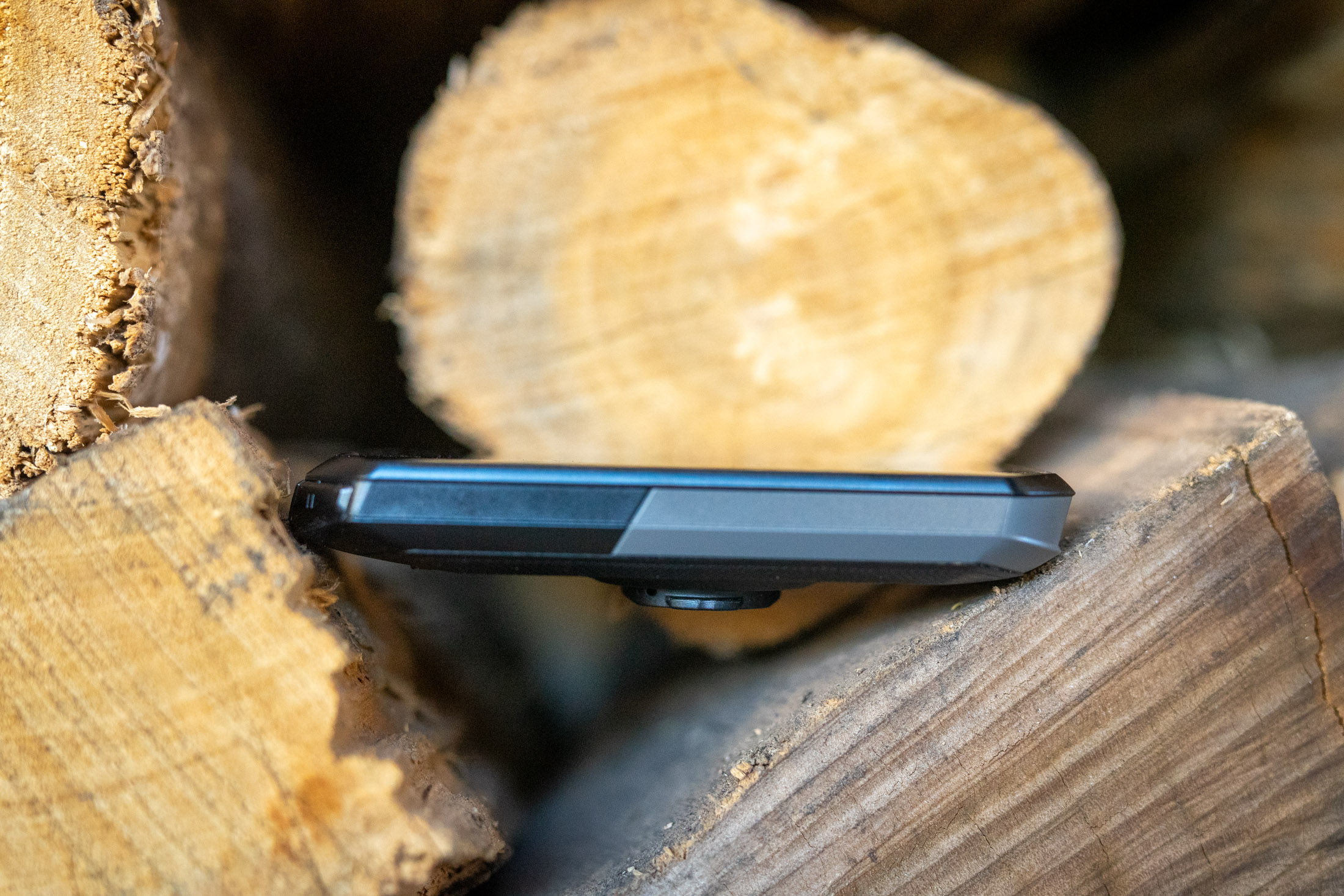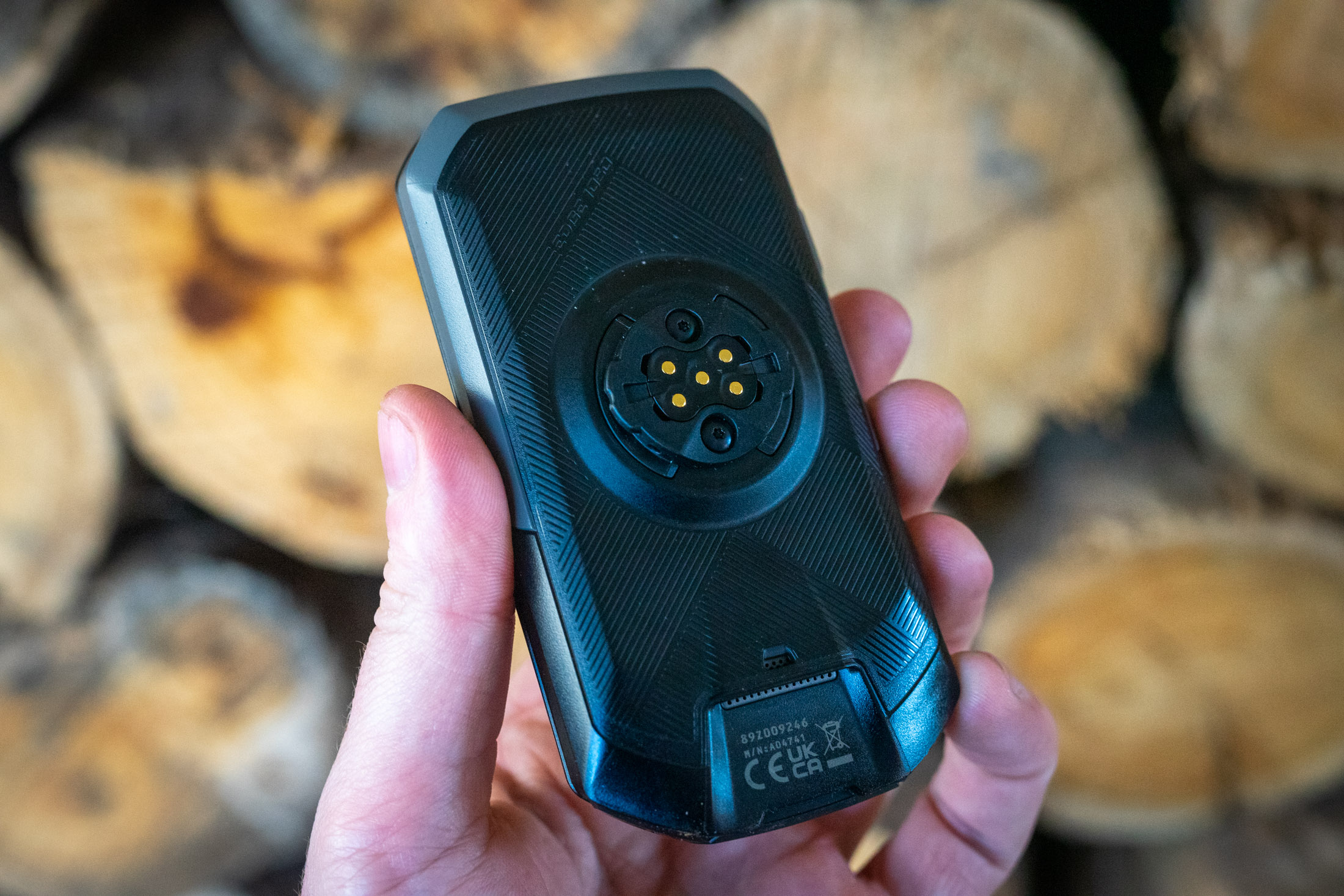It’s been a while since we’ve had our testing mits on a product from Garmin, but we’ve managed to get our grubby hands on its latest Edge 1050. At $1,199 AUD, the Edge 1050 sits atop Garmin’s range and comes with a whole haul of new features.
As integration and technology advances, bicycle computers have received their fair share of updates over the years. Live-tracking, navigation and emergency contact notification are a just few of the handy additions for mountain bikers. The Edge 1050 is no exception and receives heaps of updated features over the previous 1040 models released a couple of years ago which we’ll get into later.
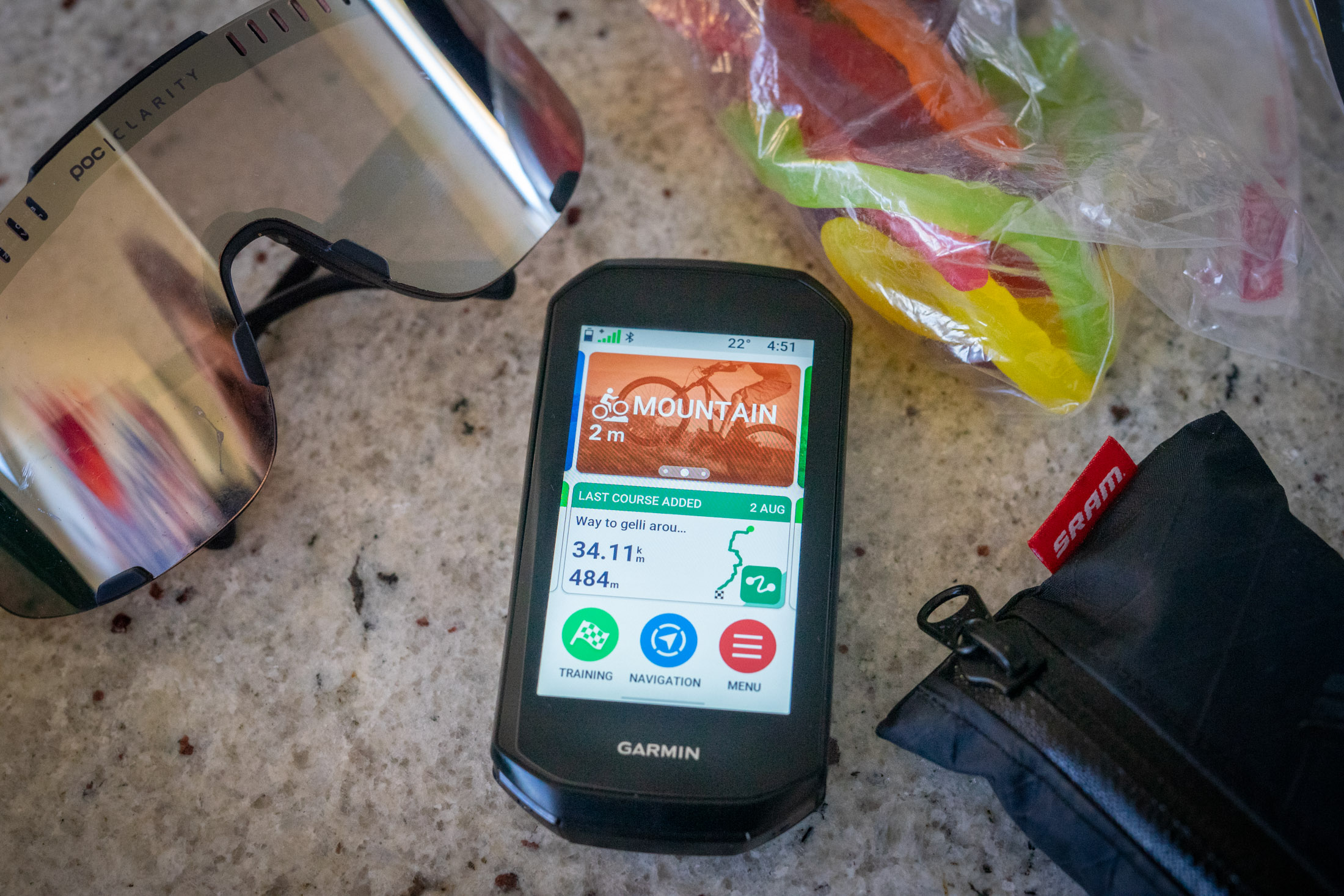
At first glance, the Edge 1050 is quite a large device, which may be an instant deal breaker for a lot of mountain bikers. Measuring in at a whopping 118mm long and 60mm wide, this is a couple of millimetres longer and wider than its predecessor. With the inherent crash risk that comes with mountain biking, we feel like enduro and trail riders are likely to opt for something a little more compact like the Garmin 840 solar. If you’re on the gravel and cross-country end of the spectrum of offroad, then the large device size of the Garmin is likely less of a concern.
The upside of the whopping device size is the increased screen real estate of the display. The larger 3.5″ AMOLED display is handy for navigation and accessing different functions on the go. It’s worth noting that it may also be too large from some integrated computer mounts like the one on this Easton EA90SL stem. The Edge 1050 just bumped the stem bolts as it clicked into place, any bigger, and it mightn’t have fitted at all.
The 1050 comes with an IPX7 waterproof rating which means it can be submerged in water up to one metre for up to 30 minutes. This is likely more than enough for your average mountain bike adventure!
The computer can connect to the GPS, GLONASS, Galileo satellite constellations and sees Multi-band GNSS capabilities. This means it can use all three at once to better triangulate your position in environments where signals may be reflecting off trees, buildings, mountains, etc. There is also a host of built-in sensors like a Barrometirc altimeter, gyroscopes, accelerometers, and magnetometer for accurate compass readings.
In the box with the Edge 1050, you’ll find several mounting options; these include flat mounts that fasten with o-rings that are also supplied and an out-in-front mount that will fit both 35mm and 31.8mm handlebar dimensions. Also included is a USB-C charger cable, although you’ll need to source your own wall plug for this.
We popped it on the scales, and the 1050 weighed in at a measly 161g, a 34g increase over the 1040 for those of you counting grams. This excludes any mounts, as there are a number of ways the device can be mounted.
Device setup and WIFI integration
Upon launching the device, you’re greeted with step-by-step instructions to quickly get the basics set up. This includes connecting your Strava accounts, entering emergency contact information and connecting to the Garmin Connect app. Once these have been connected, your home view will present you with options for different activity profiles. This lets you record different ride types (gravel, MTB or road) and save them under their each individual profile.
Within each profile you can then customise the relevant data screens and the sensors the computer will look for with each profile. That way, you won’t have any dead fields on the screen as you ride, and the computer won’t waste battery life searching for a power meter or light that’s on your other bike.
This can all be done on the device, and as the screen is so large, it’s simple to edit them to your liking. Alternatively you can do this all through your phone on the Garmin Connect app.

Once you’re connected to your phone, you’ll receive notifications for incoming calls and messages on the Edge 1050 that your mobile is receiving. This isn’t limited to regular text messages either, notifications from other apps such as Slack, Facebook Messenger and WhatsApp will also come through. These can be switched on and off through the notification settings.
When messages are received you can trigger quick replies from your Garmin also. These can be set up before your ride in settings, then once you’re on the go, you can fire off pre-formatted responses like “Yes” or “No” by tapping the screen.
The Garmin Connect app syncs with a number of third-party applications depending on your preferences. The most commonly used would be Strava, and with our mobile already logged in, connecting the Edge 1050 to our existing Strava account went off without a hitch.
The device found our location almost instantly and was ready to begin recording activities straight away.
After your ride is finished and you’ve saved your file, this will automatically be pushed to your third-party app, where it is uploaded. Garmin Connect also integrates with Zwift, Training Peaks, Ride With GPS, Komoot and MyFitnessPal if those are your apps of choice.
Much to our surprise, Trailforks wasn’t listed in the compatible apps for the Garmin Edge 1050. As this is one of the most popular apps for mountain bike navigation and features the most up-to-date information about trails around the world, we’re hopeful this will be added soon.
However, the base map still features detailed trail maps, which is one of the big selling points of these devices for mountain bikers.
New features and functions
Ding ding coming through! That’s right, the Garmin 1050 comes with a built-in bell. We weren’t quite sure if this was a gimmick or it’d actually come in handy, fortunately it was the latter. Simply tap on the screen during your ride, and a button for your bell will appear. The Edge 1040 was capable of making beep sounds but didn’t actually have a speaker built in. With the addition of this speaker opened up the opportunity to make proper bell tones.

The downside to having a bell on your Garmin is that it can be often out of reach, or not accessible in a hurry. Commonly, when reaching for a bell, you don’t have loads of time to take your hands off the bars and, more importantly, away from your brakes. It was easy enough to get to when approaching people on bike paths from a distance but if you’re in a hurry you may end up reverting to a good ol’ fashioned “Oi!”.
This is where a nifty bit of integration comes in with the bell to hopefully resolve this. With more and more riders being aboard electronic groupsets, these can be set up to integrate with the built-in bell. Both SRAM’s AXS and Shimano Di2 groupsets can program their blip/extra function buttons to speak to the device and trigger your bell. With the GRX/Red multi-function buttons or an open button on the Transmission Pod Shifters, this means you can keep your hands on the brakes and ding your bell — or shuffle through data screens hands-free. Pretty neat!
Much like you pay with your phone, you can now add your card details to GarminPay and pay with your Garmin. We don’t often leave our phones behind on rides, but we’re guessing it’ll come in handy at some point in the future.
Just as Google Maps gives users the ability to flag speed cameras, you can now mark road hazards, which can alert other riders of potholes, downed trees, or various obstacles as they approach. Without many people using this function just yet, we haven’t noticed too many alerts on our travels, mainly warnings in the maps system by default of tight corners approaching.

A feature that’s been carried over from the Edge 1040 that I’ve been misfortunate enough to put to use is the incident detection function. After entering some singletrack on my gravel bike at an overly ambitious speed, I took a trip over the handlebars. As I lay flat on my back, the Garmin started blaring an alarm sound. Once this sound starts, it means a crash has been detected, and you’ve got 30 seconds to stop the device before it sends a message to your emergency contacts. Luckily I could dust myself off, cancel the message send, and carry on my way.
This feature was initially introduced on the Garmin 820, and it was so sensitive you could set it off by braking too hard. This problem has persisted through a few generations of Garmin devices, but so far, I haven’t been able to trigger the incident detection when it hasn’t been called for.
Battery Life and Display Brightness
Both the battery life and display brightness of the Edge 1050 have been a standout. Garmin claims a 20 hour battery life and 60 hours in their battery saver mode. After an 8-hour day on the bike with the head unit in the regular power mode, the device still had 60% charge, which, with some back-of-the-bar napkin math, should put it pretty darn close to Garmin’s claims.
This test was with no sensors paired which it’s worth noting will speed up battery drain. Charging is done through the supplied USB-C to USB-C cable, and you’ll have to source your own wall plug for this. The 1050 has no solar re-charging built in, meaning it’ll run out of charge significantly quicker than the Edge 1040 solar, which can last for up to a claimed 100 hours.
If you’re planning bigger adventures and need a longer run time, the existing Garmin charge packs will work with the 1050. This battery pack adds up to 24 hours of run time and adds an extra 132g to the overall system weight.
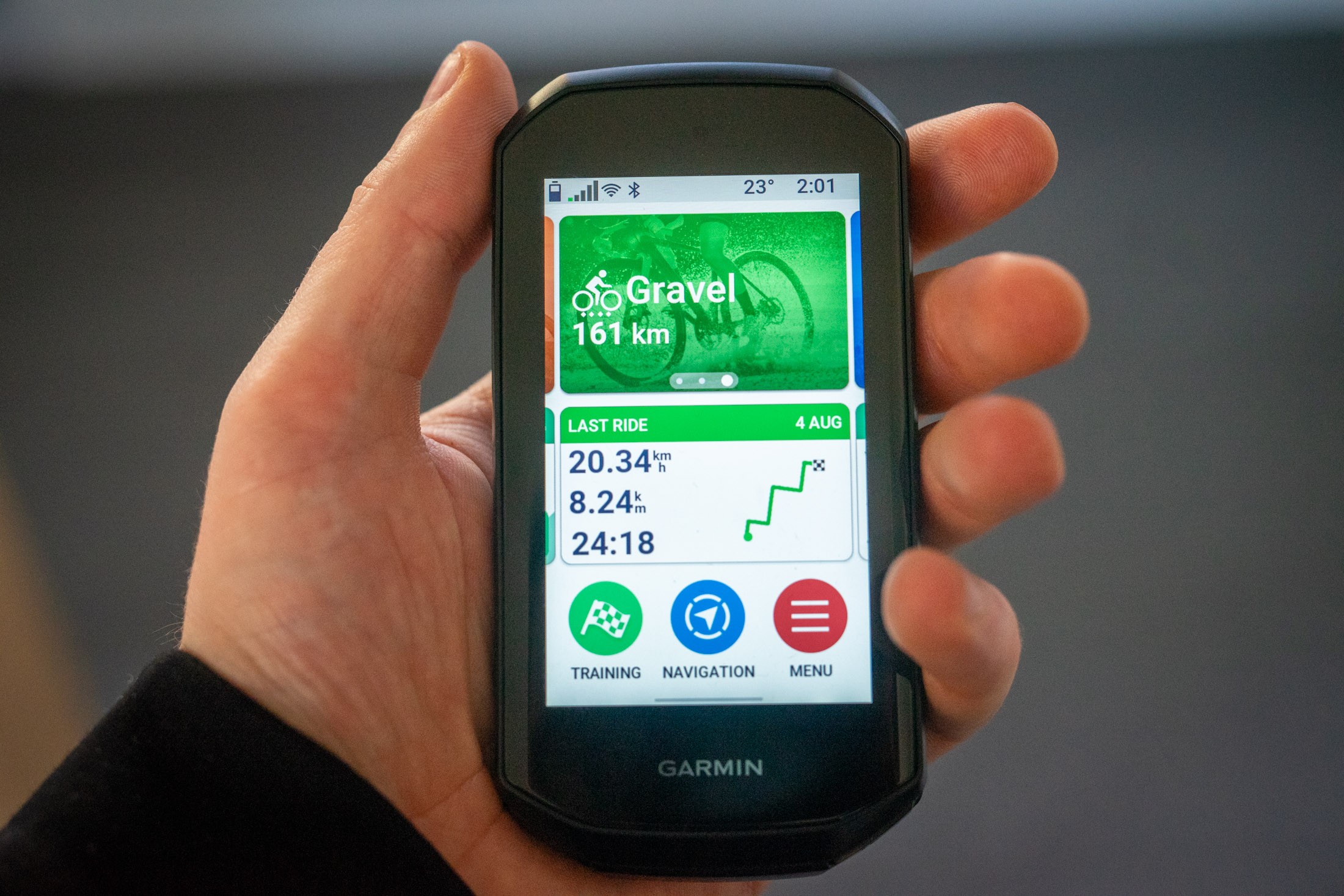
With such excellent battery management, there were still no issues of a dim or poorly lit screen. Even with sunglasses on, the display can be clearly viewed and adjusts its brightness seamlessly with surrounding light conditions.
We’ve also been pleasantly surprised at just how quick and responsive the touch screen is, there’s no freezing or lagging which is handy when you might be swiping through screens on the move. The touch screen feels similarly responsive to most modern mobile phones.
Moisture doesn’t impact the functionality of the screen much at all, we were still able to swipe through modes and access the menus we needed. Gloves, however, continue to be an issue with touch screens. Unless your gloves have little touchscreen pads built into the fingertips, you’ll be whipping them off the functions you need.
Navigation and mapping
During our time so far with the Garmin Edge 1050 we’ve used maps created both in Garmin Connect and on Strava. Loading either option onto the device is straightforward. Once the course is saved into the routes of the respective apps, it’ll be synced to the device.
With the large LCD screen, you can create your own routes from scratch on the device. Although it’s not quite as simple as creating them on a computer, it’ll work in a pinch if you’re looking to pull something together. Nine times out of ten, though, we’ll still take the option of planning a route on the computer for the added detail and flexibility.
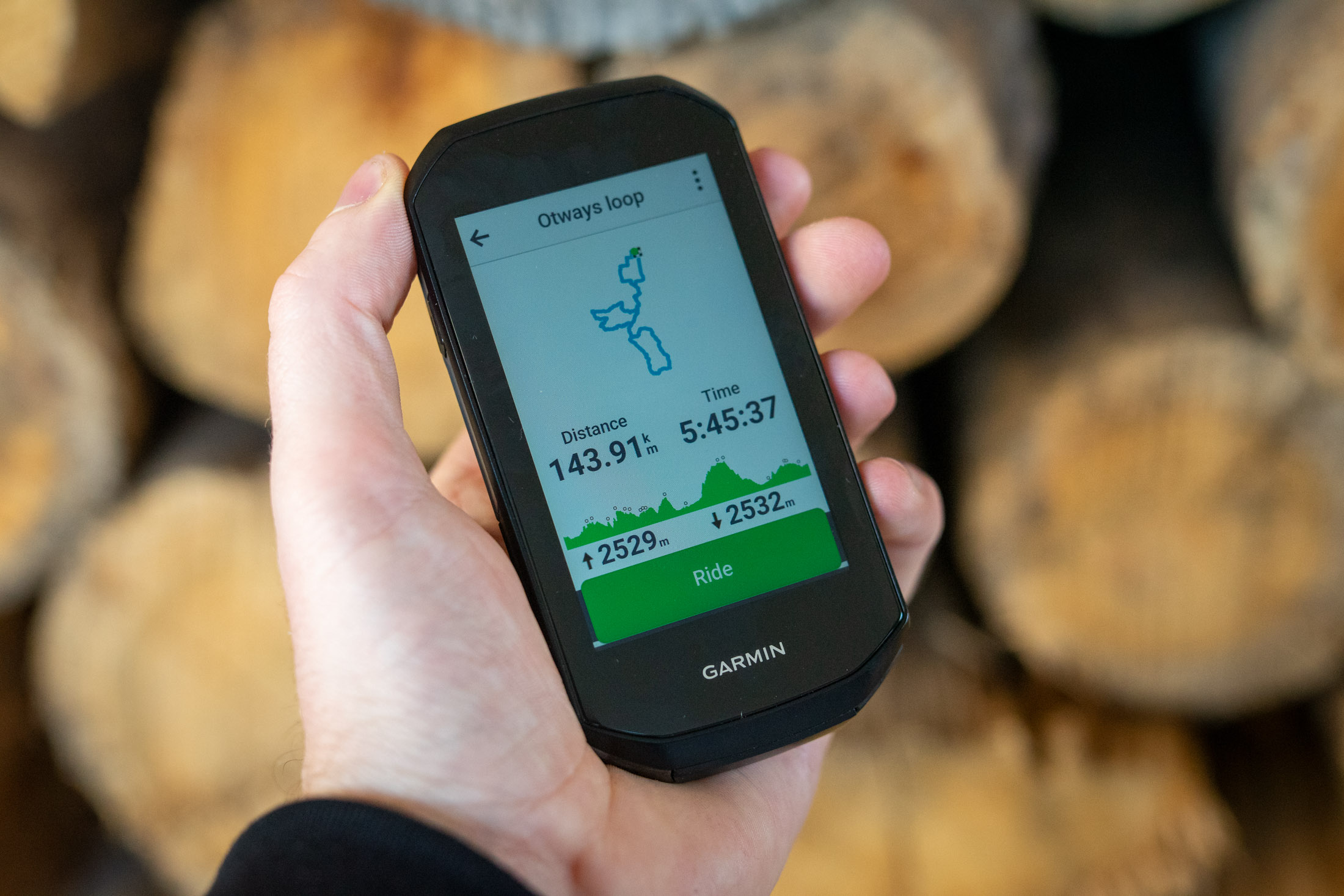
We went relatively remote into the bush on a few gravel rides to test out routes made on the device, such as Strava and the Garmin Connect App, and it seems like they all have similar shortcomings. Each provides options for the type of ride you’d like to do and allows you to drag and drop the course to your preference. Where this comes up short is on unknown smaller roads, which can occasionally lead to a dead end. The best way we’ve found to avoid this is to check out Strava heat maps first and plan your route based on this, more popular trails and roads will appear hotter and make for a better ride.
Once the map is loaded, it’s much like navigating on a phone in your car. You’ll receive the occasional beep when approaching a tight turn, or if you’ve reached the base of a climb or start of a segment.
The few times we have ran into routing issues, we’ll simply pedal an alternate way until the Garmin recognises we’re off course (usually within 30-50 metres) and you’ll receive a notification asking if you’d like to re-route. Once selected, re-routing takes anywhere from 5-15 seconds, and you’ve got your new course. If you do fire up a route before reaching it, the Edge 1050 quickly identifies this and asks if you’d like it to navigate to the beginning of the route.
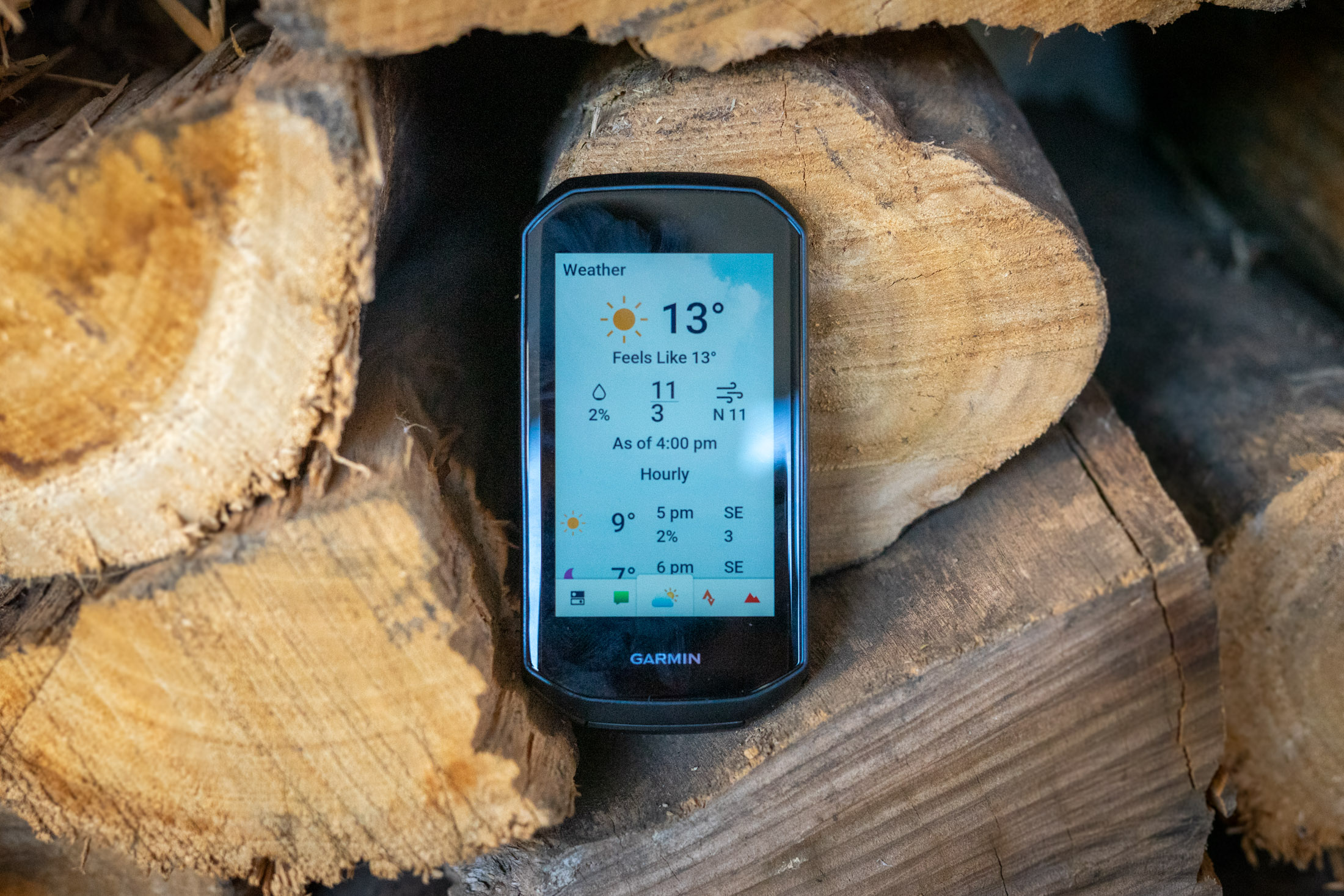
Flow’s Take
So far, we’ve been pleased with the overall performance of the new Edge 1050. Despite the girthy size of the device, it’s worked brilliantly for navigation out on rides, and setup was straightforward with the intuitive user interface.
All of this functionality does come at a price, though, with the whopping price tag of $1,199, the Edge 1050 won’t be for everyone. That’s double the price of Wahoo’s ELEMNT Roam computer!
Riders spending lots of time mapping routes or navigating to remote areas for multi-day rides will get the most out of all the features jammed into the Edge 1050.
For riders who are lapping enduro runs and chasing downhill KOMs, there’s a good chance you’re better suited to a more compact device with a simpler feature list, like the Garmin Edge 840 or Wahoo ELEMNT Bolt.
If you’re doing big days in the saddle that require navigation, or you need maximum battery life for multiple days of riding in a row, then the 1050 is likely a good fit. For those extra large adventures, the added flexibility of adding a battery pack gives much greater range. This in combination with battery saver mode will bring you close to the 100 hour battery life of the 1040 Solar.

